Planing the Workshop
- Fill in Workshop Ideas on the Dotstorming Brainstorming Board
Storytelling Matters!
Scott’s presentation guru, Garr Reynolds, stated it best at his site, presentationzen.com: “We are a storytelling animal. We are not a bullet-point-memorizing animal. We are wired to be attracted to story and to learn from them and to spread them.” “The best stories infuse wonder,” says Pixar’s Andrew Stanton. Come learn how to tell better stories, engage and not enrage your students. (New and improved distance learning edition!)

Know this… PowerPoint is Evil!
Imagine a widely used and expensive prescription drug that promised to make us beautiful but didn’t. Instead the drug had frequent, serious side effects: It induced stupidity, turned everyone into bores, wasted time, and degraded the quality and credibility of communication. These side effects would rightly lead to a worldwide product recall.
Taken from WIRED; PowerPoint Is Evil. Power Corrupts. PowerPoint Corrupts Absolutely. By Edward Tufte
Contribute to the Pre-session and TPEP Survey

- Take the Presentation / Session TPEP Prioritization Agenda Survey
- This is a standards-based presentation/session
- Gathering data from students/teachers can help you prioritize the most engaging content
- Scott placed the TPEP standards which are based on the Danielson Model in a Google Form
- What would you like to learn from this session?
- What domains and components (Standards) would you like highlighted through this session?
- Data gathering is essential for tracking growth, help Scott differentiate the experience to your needs
Review Participant Data To Set Session Goals
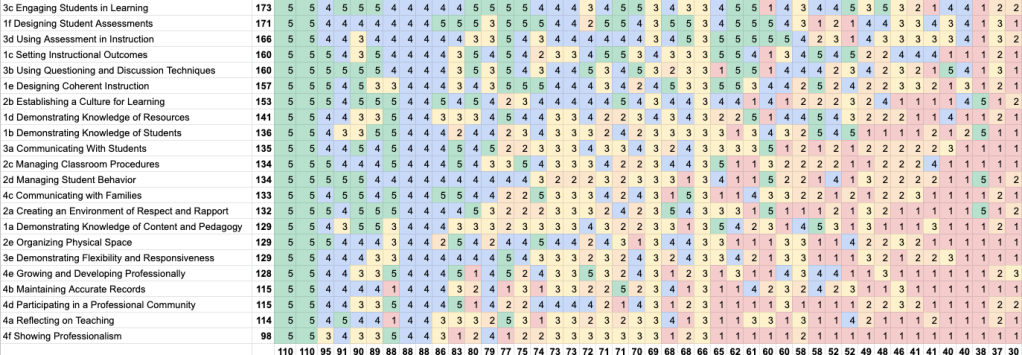
- Review the spreadsheet of data (Link is only for Scott to use live)
- Watch Scott’s Session Goal Setting with Data YouTube Tutorial
Top TPEP Requested Component…
- #1 is… 3c Engaging Student Learners (Danielson description PDF), example student behaviors below:
- Students take the initiative to improve the lesson by (1) modifying a learning task to make it more meaningful or relevant to their needs, (2) suggesting modifications to the grouping patterns used, and/or (3) suggesting modifications or additions to the materials being used.
- Students have an opportunity for reflection and closure on the lesson to consolidate their understanding.
- Students are asked to write an essay in the style of Hemmingway and to describe which aspects of his style they have incorporated.
- Students determine which of several tools—e.g., a protractor, spreadsheet, or graphing calculator—would be most suitable to solve a math problem.
- A student asks whether they might remain in their small groups to complete another section of the activity, rather than work independently.
- Students identify or create their own learning materials.
- Students summarize their learning from the lesson.
Post to Our Session Parking Lot

- A Padlet parking lot is a great place for students/teachers to post ideas asynchronously
- This Workshop’s Parking Lot link: https://bit.ly/PadletParkingLot
- This Workshop’s Parking Lot QR Code: (Padlet generates one automatically)

Play Bingo – sort of…
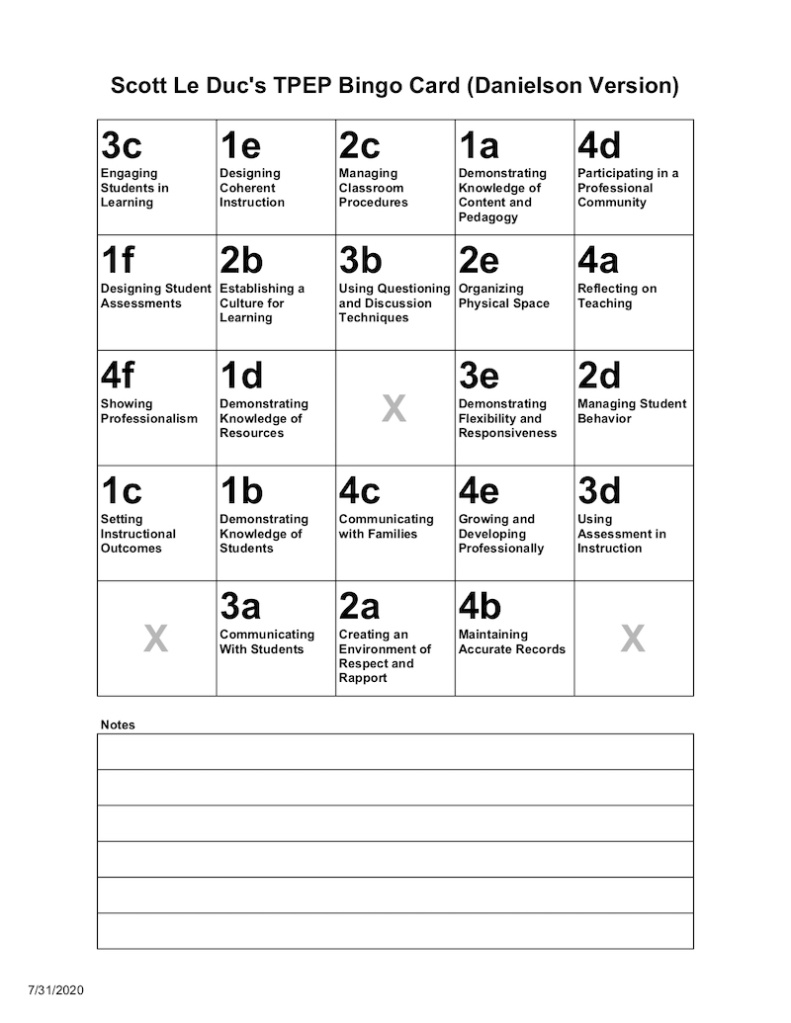
- SIMPLE TPEP Bingo Card – Danielson (above) (PDF)
- DETAILED TPEP Bingo Card – Danielson (has the State 8) (PDF)
- Playing bingo with standards is a great way to activate the gaming mentality in students/teachers – get them looking, searching in your curriculum – doing is learning!
Contribute to the 21st Century Skills Treasure Hunt
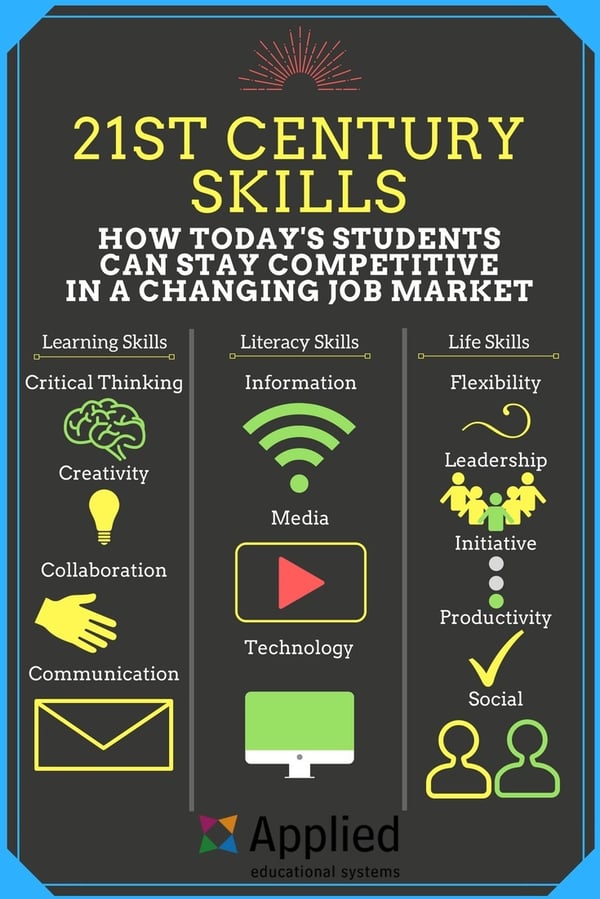
- Gather ideas for 21st Century Skills structure and process through students building and presenting presentations collaboratively
- Add your ideas to your TPEP Bingo Card or Our Session Padlet Parking Lot
- Research 21st Century Skills
Endure Scott Le Duc’s Introduction

- Decide whether he is credible, or not
- Started teaching CTE Arts and Technology in 1996 at Capital High School in Olympia, WA
- Achieved National Board Certification in CTE (2014)
- Selected as one of the top presenters at numerous CTE conferences
- He stuffed the ballot box! – shhh…
- Can moonwalk and touch his tongue to his nose
- Known to be a nice guy, occasionally
Contemplate Scott’s Presentation Goal
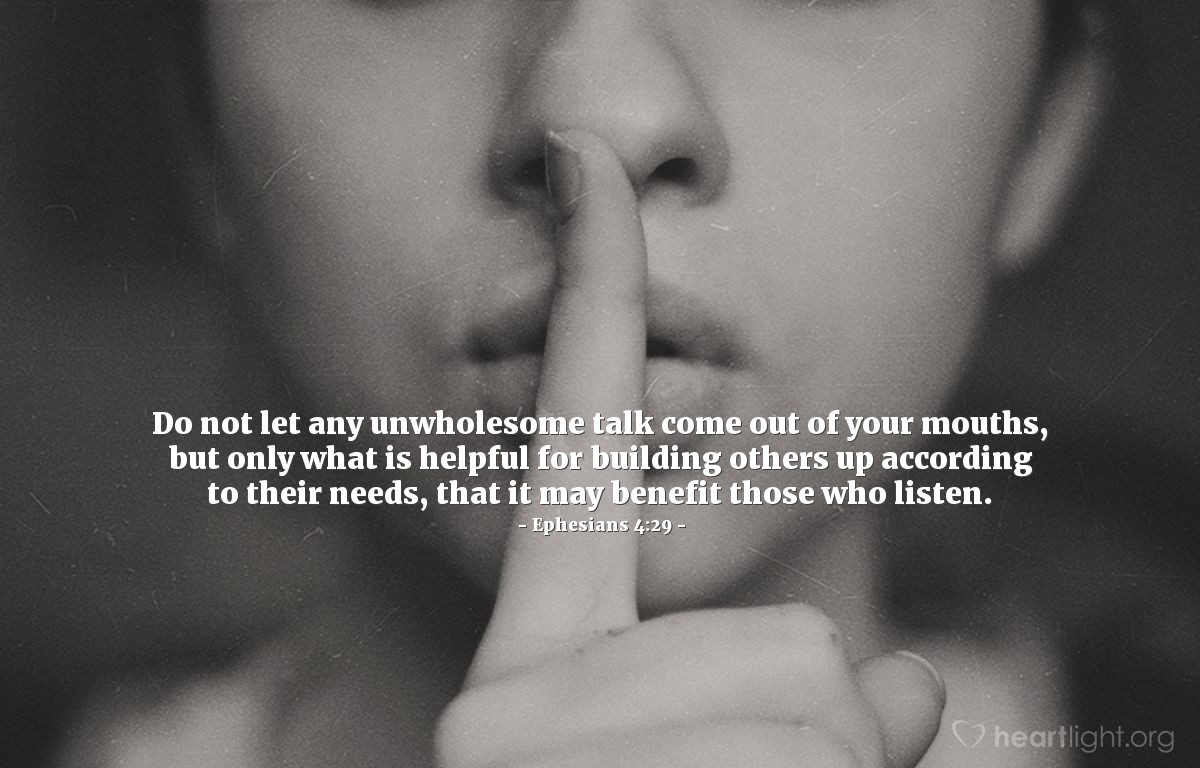
Designed with Andragogy for the ADULT Mind
- Need to know: Adults need to know the reason for learning something.
- Foundation: Experience (including error) provides the basis for learning activities.
- Self-concept: Adults need to be responsible for their decisions on education; involvement in the planning and evaluation of their instruction.
- Readiness: Adults are most interested in learning subjects having immediate relevance to their work and/or personal lives.
- Orientation: Adult learning is problem-centered rather than content-oriented.
- Motivation: Adults respond better to internal versus external motivators.
Remember, Andragogy can be for Young ADULT Mind’s, too!

Infused with Bloom’s Taxonomy Verbs

- For a more detailed description of Bloom’s Taxonomy examine the Model Questions and Key Words PDF
- Examine 126 Bloom’s Taxonomy Verbs For Digital Learning
- Scott’s Rubric Builder (help Students Build Rubrics with Bloom’s Verbs)
- REDO – No evidence of standard
- LIST the stages and procedures used in the recording process. APPROACHING STANDARD
- DESCRIBE the stages and procedures used in the recording process. MEETS STANDARD
- DEMONSTRATE the stages and procedures used in the recording process. EXCEEDS STANDARD
Example of a Bloom verbs-based rubric where the ‘standard verb’ was ‘describe’ with the lower level verb was ‘list’ and higher level verb was ‘demonstrate’
Contemplate That The Brain Can Only Absorb What The Butt Can Endure

Contact Scott for Information, Resources, and Training
- sleduc@osd.wednet.edu (Olympia School District)
- scottleduc@gmail.com (Personal)
- Scott’s presentation social bookmarks at Diigo.com
- Scott’s Capital High School site
- Scott’s Capital High School Blog – CapitalComTech.info (Curriculum)
Get On With It!
Why?
- Consider these three things students and teachers need for the world of work:
- Show, don’t tell (it’s put up or shut up)
- Need to communicate effectively and in various formats
- Need to stand out
- Bio and Portfolio Requirements
- Your bio should address the following 5 questions
- Who am I?
- How can I help you?
- How did I get here (i.e. know what I know)?
- Why can you trust me?
- What do we share in common?
- Social Media Literacy is Required
Examine Science and Research
- Examine Brain Science and Research
- Brain Rules by John Medina
- Made to Stick by the Heath Brothers
- 2 + 2 with Andrew Stanton
- Start from the 6:25 minute mark
What? (13 min.)
- Student Example
- Explore Presentation Styles and Resources (10 min.)
- Lawrence Lessig Free Culture Presentation (3 min.)
- Dick Hardt (3.5 min.)
How? – The Planning Stage (The Paper Part) (30 min.)

- The Preparation Stage
- Garr Reynolds DVD – Preparation Stage (7 min.)
- Video (Private)
- Brainstorm and Brainwrite Ideas (Right Brain) (10 min.)
- Explore Life Hack for Generating Ideas
- Use on paper
- Use FreeMind on computer
- Explore ideas to jump start idea generation
- “F” Words – Family, Food, Fun, Friends, Fondness, Fundamentals, Frequency, Foundation, Faith, etc.
- Want to hook into each audience member at least once

- Draft Paper Story Board (Left Brain) (10 min.)
- Create a paper draft layout or mock-up of the your slides
- Folder a piece of paper so there are 16 sections, use each one to draw a draft of the slide
- Write the actual words that will appear on each slide or write which picture will appear on the slide, example: PICT OF CAT
- The goal is to have hooks represented as images or text about you that will help you connect with your audience
- Story board resources
- Create a paper draft layout or mock-up of the your slides

- Pitch The Storyboard (10 min.)
- Use the paperwork and pitch the flow of the presentation to others
- This will act as practice for both the content and delivery
- 1 to 20 rule
- Every minute of presentation time require 20 minutes of preparation time
- Use the paperwork and pitch the flow of the presentation to others
How? – The Building Stage (The Technology Part) (45 min.)
- Type a Slide List (Script) (5 min.)
- Microsoft Word
- Microsoft PowerPoint
- Google Slides
- Apple Keynote
- Create a PowerPoint Master Slide Template (5 min.)
- Create a slide master background
- Choose black
- Darks appear further away
- You own ‘the presentation wall’ – there is no border
- Choose font and font color(s) for presentation
- Choose white
- Maximize contrast with background
- Do not change colors during the presentation, unless you have a specific reason
- Change activates attention, do it deliberately
- Color in Motion (YouTube)
- Create a slide master background
- Place Text in Slide Outline (5 min.)
- Save to the class shared
- Discuss Copyright and Creative Commons (10 min.)
- Lawrence Lessig and Copyright (TED)
- Watch first 9 minutes
- Lawrence Lessig and Copyright (TED)
- Gather Images from Flickr.com (10 min.)
- Flickr and Creative Commons Searching through Search.CreativeCommons.org
- Be sure to cite sources
- MLA Formatting example
- Date download
- Website
- Author
- Title of image
- Flickr and Creative Commons Searching through Search.CreativeCommons.org
- Publish Slide show (10 min.)
- Upload to Slideshare.net
- Use VoiceThread.com to host presentation and record audio, if you cannot present ‘live’
- Examine Scott’s VoiceThread resources from 10 years ago – kinda funny!
How? – The Presentation Stage (Stand and Deliver Part)
- Present Your Slideshow (45 min.)
- Watch How to Present with Power and Poise (30 min.)
- Watch 11 Things to Never Say in a Presentation (3 min.)
- Examine the 4 A’s of Being a Good Audience Member (2 min.)
- Discussdifference between practice and preparation by Stephen Tobolowsky (10 min.)
- Start at 13:00 to 23:30
- Use VoiceThread.com (to record narration with the slides)
- Use Screencastify to record your desktop
The “Do My Slides Suck” Test from Kathy Sierra
- Do your slides contain mostly bullet points?
- Do you have more than 12-15 words on a slide?
- Do your slides add little or no new info beyond what you can say in words?
- Are your slides, in fact, not memorable?
- Are your slides emotionally empty?
- Do your slides fail to encourage a deeper connection to or understanding of the topic?
- Do your slides distort the data? (That’s a whooooole different thing I’m not addressing now)
- Do your slides encourage cognitive weakness? (refer to Tufte)
Scott Le Duc’s Student Presentation Projects and Resources
Scott’s STUDENT INTRODUCTION PRESENTATION Project

- My Presentation Directions (including creating a blog post about the creation process)
Scott’s PRESENTATION SLAM Teams Resources

- Presentation Slam instructions
- We use the slam to develop presentations of terms and concepts to Thinking / Knowledge content
- Presentation Slam Feedback Form (PDF)
Team Practice, Preparation, and Presentation Feedback Forms

- Team Presentation Form 5 Film (PDF)
- Team Presentation Form 5 Game (PDF)
- Team Presentation Form 5 Rock (PDF)
Use Kahoot.it After The Presentation
- Want to know what students retained from your presentation?
- UseKahoot.it to quiz them on the content
- This is great formative assessment and will inform your decisions on future content and process
- Have students make a Kahoot for thier own presentations!
The Tools
- Paper (right brain – brainwrite and brainstorm)
- Folded paper (folded 4 times, to be specific) (left brain – storyboard)
- Microsoft PowerPoint
- Apple Keynote
- Open Office Impress
- Google Slides
- Voicethread
Ouch You’re Hurting My Brain
Let’s look at our audience. A good presenter should know their audience. Last time I noticed, I was presenting to humans. John Sweller’s Cognitive Load Theory details the limitations of the human mind to hold discrete pieces of information in short-term memory. Explore more of John Sweller’s take on PowerPoint and it’s limitations in the PresentationZen.com post, Is it finally time to ditch PowerPoint? It is a must read. Supposedly, phone numbers are only 7 digits long because the mind can only hold seven pieces of information in short term memory, plus or minus two numbers depending on other variables according to George A. Miller . There are strategies like “Chunking“, an idea that we can more efficiently use short-term memory, but in general we are limited by what we can absorb in a short period of time. Something to consider when presenting to homo sapiens.
Limitation By Design
I know when I started working with PowerPoint I was excited to build beautiful templates and have all kinds of cool effects happen during slide transitions. Getting the ornate 3D charts and graphs to represent my data seemed like the thing to do. I spent a lot of time trying to figure out this wizardry just to find out that it actually distracts from my presentation’s message. The templates are worse for your presentation than starting with a simple plain layout.
Stand and Deliver
Forgive me, I have sinned. I used to “talk to my slides” during presentation. Reading them word for word is the ultimate way to kill your audience’s interest in your topic. How we interact with the information on the screen can either add or detract from the colors, fonts and images in the slides. Kathy Sierra details great advice and cites resources to improve presentations in her blog entry; Stop your presentation before it kills again! Something else to consider, we are emotional creatures. Use this in your presentation. Seth Godin comments in his post, Really Bad PowerPoint supports this; no emotion, no connection.
Learn From The Best
Some of the best presenters are Lawrence Lessig, Guy Kawasaki, Seth Godin, and Dick Hardt. Examine their approaches.
Example Presentations
- Lawrence Lessig Presentation on Free Culture
- Dick Hardt inspired by Lessig presented the OSCON 2005 Keynote – Identity 2.0.
- Seth Godin Presentation Example
- Guy Kawasaki 10 – 20 -30 Rule Presentation
Post-session Survey
- Please fill in the anonymous What Works and What Doesn’t Google Form
- Here is a another version with names: More of, Less of Feedback Form
- This will help improve these workshops – THANKS!
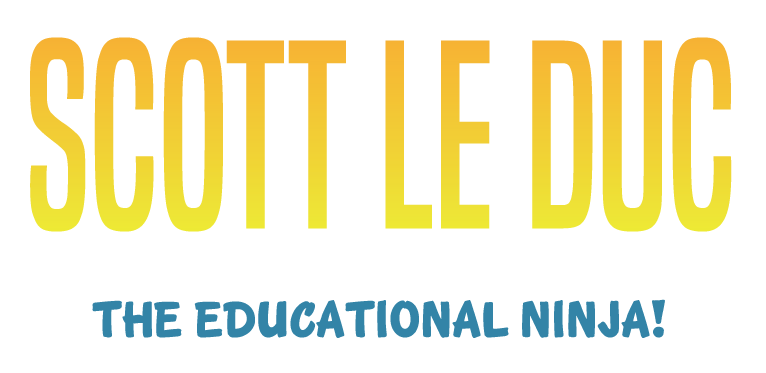

One thought on “Creating Presentations That Don’t Suck”